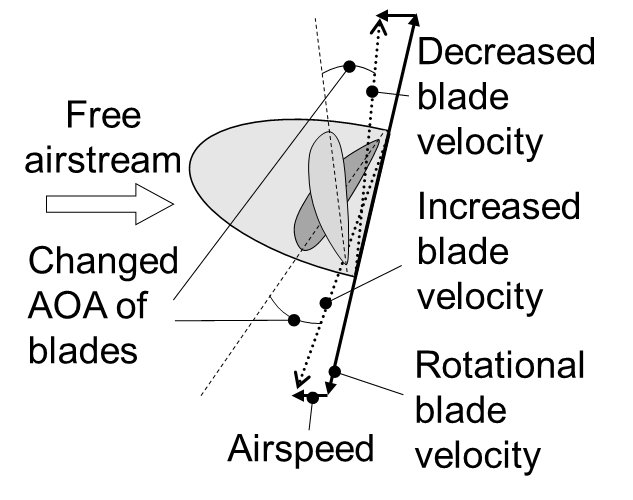P-factor
<templatestyles src="Module:Hatnote/styles.css"></templatestyles>
<templatestyles src="Module:Hatnote/styles.css"></templatestyles>
<templatestyles src="Multiple image/styles.css" wrapper=".tmulti"></templatestyles>
P‑factor, also known as asymmetric blade effect and asymmetric disc effect, is an aerodynamic phenomenon experienced by a moving propeller,[1] wherein the propeller's center of thrust moves off-center when the aircraft is at a high angle of attack. This shift in thrust location creates a yawing moment, causing the aircraft to yaw to one side. Rudder input is required to counteract this tendency.
Causes

At cruise speed and level flight, the propeller disc is perpendicular to airflow, creating balanced thrust. In nose-high attitudes (e.g., climb), the disc tilts, and blades descend forward or ascend backward:
- **Down-going blade** (clockwise rotation): more forward speed → higher airspeed → more thrust
- **Up-going blade**: less forward speed → lower airspeed → less thrust
This asymmetry shifts thrust center toward the more thrustful blade.[2]
Disc tilt also alters blade AOA:
- Down-going blade → increased AOA → more thrust
- Up-going blade → decreased AOA → less thrust
Even though higher forward speed would reduce AOA, the tilt effect dominates, resulting in increased AOA and thrust for the down-going blade.[3][4]
P-factor is most pronounced during high AOA and high power, such as takeoff.[1][5]
Effects
Single-engine aircraft
For clockwise propellers (viewed by pilot):
- Climbing → yaw left
- Descending → yaw right
Countered via rudder. Spiral slipstream also contributes.
Tailwheel aircraft show more P-factor on takeoff due to disc tilt. Less noticeable on landing due to low power settings.
Multi-engine aircraft
If propellers rotate in the same direction:
- The engine with down-moving blades toward the wingtip causes stronger yaw
- The other engine becomes the "critical engine"
P-factor impacts minimum control speeds (Template:V speeds), which are based on the failure of the critical engine.[6]

Helicopters
In forward flight:
- Advancing blade → more lift
- Retreating blade → less lift (dissymmetry of lift)
Compensated by cyclic pitch adjustment. Otherwise, imbalance causes roll and backward pitch ("flap back").[7][8]
See also
References
- ↑ 1.0 1.1 Lua error: bad argument #1 to "get" (not a valid title).
- ↑ 8 Yaw-Wise Torque Budget. Retrieved from link
- ↑ Lua error: bad argument #1 to "get" (not a valid title).
- ↑ P Factor?. Retrieved from link
- ↑ Prop Effects. Clay Ramskill. (June 2003) SMRCC. Retrieved 2009-04-27 from link
- ↑ Lua error: bad argument #1 to "get" (not a valid title).
- ↑ Lua error: bad argument #1 to "get" (not a valid title).
- ↑ Watkinson, John: "The Art of the Helicopter" (2011), Pg 90.


